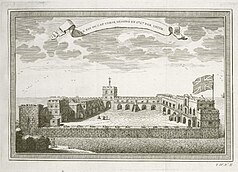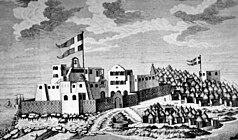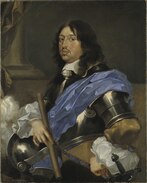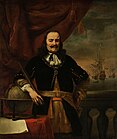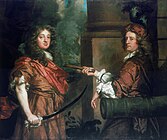Dano-Dutch colonial conflict on the Gold Coast
| Dano-Dutch War | |||||||||
|---|---|---|---|---|---|---|---|---|---|
| Part of the prelude toSecond Anglo-Dutch War | |||||||||
| |||||||||
| Belligerents | |||||||||
| Commanders and leaders | |||||||||
|
|
| ||||||||
| Strength | |||||||||
|
England: 6-7 ships Denmark-Norway: Unknown | 13 warships | ||||||||
| Casualties and losses | |||||||||
| Denmark-Norway: 2 ships[2] | Unknown | ||||||||
TheDano-Dutch colonial conflict on the Gold Coast(Danish:Dansk-Hollandske kolonikonflikt på Guldkysten,Dutch:Deens-Nederlands koloniaal conflict aan de Goudkust) was a colonial conflict between theDanesandDutchover the control of European fortifications on the Gold Coast.Denmark-Norway,assisted byEngland,defeated the Dutch in various places, althoughMichiel de Ruyterretaliated against the English byrecapturing all fortsbutCape Coast.[a]This forced theRoyal African Companyintobankruptcy,which started theSecond Anglo-Dutch War.[3]
Background and prelude
[edit]Since 1655, theSwedish Empirehad waged war against thePolish-Lithuanian Commonwealth.Eager to regain Denmark'slost territories in 1648,Frederick IIIdeclared war on Sweden.[4]In responseCharles X Gustavsurprisingly turned his army towardsJutland.[5]The Harsh winter of 1657/1658 led to the freezing ofthe Belts,and the Swedish army exploited this bymarching across them.[5]Completely unexpected for Frederick, he was compelled to sign theTreaty of Roskilde.[5]
The Danes stalled and prolonged the fulfillment of some of the provisions of the Treaty signed atRoskilde,and Charles could thus use this as an excuse for planning to vanquish Denmark as asovereign state,anddeclared waron Denmark[5]
Dano-Dutch alliance
[edit]
Denmark and the Dutch Republic had previously signed adefensive alliance,and the Dutch Republic was hesitant to establish peace in theBaltic Sea.[5]The warfare quickly spread to theEuropean colonies.The Danes had two years earlier in 1658, conquered the newly established Swedish fort ofCarolusborg[6][7]and now the Dutch and local tribes were interested in Carolusborg too.[1]In the following years the castle switched hands multiple times. In 1659 the Danes under Immanuel Schmid, gave the Castle of Cape Corso, as well as the castles inAnamaboandOsuto the Dutch.[6][2][1]After this, the natives of Fetu (also known asAfutu) besieged Cape Corso and successfully took it in 1660.[6][1]However, theSwedeswere able to regain control and held the castle from1660to1663.[6][1][8]In a surprising turn of events, the Fetus retook the castle from the Swedes in 1663, throughtreachery.[6][1]However the Fetus handed over the fort to theDutchthe same year.[6][2][1]
Tensions on the Gold Coast
[edit]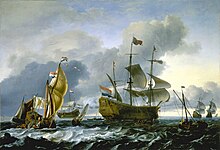
When two Danish vessels in late 1659 showed up off thecoast of Ghana,they were received with the news that the Danes no longer controlled Cape Corso.[2]The crew negotiated with the local fetus for other possible forts. They came to the conclusion that forc. 1500Danish rigsdaler,they were ceded the previousPrussianfort of Friedrichsburg (Danish:Frederiksborg) and a smalltrade outpostbetween Frederiksborg and Cape Corso. In the same year they also were given a small Dutch trading post near Cong.[2][9]As a result, Denmark had threestrongholdsin Ghana. The following year, 1660, the English established theRoyal African Company[10][11]with the goal of competing against the Dutch control of theAtlantic slave trade.[10]The Dutch feared that the English might cease control of the weakerDanish outpostsand thereby participate in the lucrative slave trade.[2][9]They therefore launched small scale raids on Danish bases and ships inAfrica.The Dutch claimed that the Danes had forcefully driven them away from their lodge at Cong and on April 24, 1661, they attacked the Danish lodge at Cong and burned it down.[2]The personnel present were taken to the DutchFort Nassaulocated further east inSabu.
The Dutchraidsagainst Danish vessels in the area continued and in 1662,[2]two Danish ships were attacked and captured. Several other ships were also targeted, but in many instances, the Danes managed to repel the Dutch attacks.[2][8]
In December 1662, a Dutch force led by CommanderValkenburghattacked a new Danish lodge at Bagos, near theSierra Leone River.Two ships bombarded the Danish lodge, and later the crew went ashore and captured the lodge and valuablegoods.[2][8]More significant attacks to the Danish forts came in 1664, in response to therecent confrontationwith England.[2][1]
War
[edit]Frederiksborg
[edit]On March 23, 1664, the Dutch launched an attack on the small trading post located between Capo Corso and Fredriksberg.[2][1][9]Additionally, theybombardedFredriksberg(which only lay a cannon shot away from cape corso) by the sea for several days and initiated asiegeof the fort.[2][9]The fort'sgarrisondefended themselves with the assistance of local Fetu warriors who were affiliated with the fort.[2]The English who were recently at constant competition with the Dutch,[11]were quick to help. On 14 April, the English admiral,Robert Holmeswas sent with 6-7 vessels to assist the besieged Danes.[1][2][11]At the arrival of the English on the coast of Frederiksborg, the Danes now faced the cannons towards Cape Corso and with English help bombarded thefortress.[1]
Cape Corso
[edit]8 days in a row, Cape corso was bombarded by the sea side and from Frederiksborg.[1][9]A combined Anglo-Danish army had landed nearby Cape Corso and had too, started bombarding the castle.[2]The bombardments were to weaken the garrison at the castle, for the troops to eventually launch anassaulton the fort.[2][9][8]This was not needed though, and the Dutchcapitulatedthe fort to the English, who named it Cape Coast Castle.[2][1][8][10]
Aftermath
[edit]The Danish presence at the Gold coast was saved by the English[2][1]and would go on until 1850.[12]In retaliation for the bombardment of Cape Corso, the Dutch admiral,Michiel de Ruytertried to recapture the lost possessions by 13men-of-war.[6]This confrontation escalated to theSecond Anglo-Dutch War[10]and as a result of a delay in receiving orders, theNorwegian commanderssided with the Dutch atVågen,[13]despite a secret agreement byFrederick IIIandCharles II.Denmark was thus forced to jointhe Netherlandsand peace was concluded in 1667 atBreda.[14]
See also
[edit]- Swedish Gold Coast– Swedish colony in present-day Ghana
- Commonwealth of England– Republican rule in England, 1649–1660
- Dano-Swedish War (1658–1660)– War between Denmark–Norway and Sweden that took place between 1658-60
- Dutch East India Company– 1602–1799 Dutch trading company
- Sagbadre War– 1784 Danish punitive expedition in Gold Coast
Notes
[edit]- ^Alternative names include Carolusborg (Swedish), Carlsborg (Danish), Cape Corso (Portuguese)
References
[edit]- ^abcdefghijklmnoLarsen, Kay (1918).De Danske i Guinea[The Danes in Guinea](PDF)(in Danish). Copenhagen: Nordisk fortfatter forlag. pp. 20–23.
- ^abcdefghijklmnopqrsGeisler, Jens (2013).Dansk-hollandsk kolonikrig i Guinea[Danish-Dutch Colonial War in Guinea] (in Danish). Dansk Militærhistorie.
- ^Rommelse, Gijs (2006).The Second Anglo-Dutch War (1665-1667): raison d'état, mercantilism and maritime strife.Uitgeverij Verloren.ISBN978-9065509079.
- ^"Frederik 3. (1648 - 1670)".Nationalmuseet.
- ^abcdeFrost, Robert (2000).The Northern Wars.pp. 179–180.
- ^abcdefgReindorf, Christian (1895).HISTORY OF THE GOLD COASTAND ASANTE(PDF).Basel: the Missionsbuchhandlung. p. 14.
- ^Sjøblom, Christer (Autumn 2022).Christiansborg on the Gold Coast(PDF).Oslo: Institutt for arkeologi, konservering og historie. p. 8.
- ^abcdeFedbæk, Ole (2015).Kolonierne i Asien og Afrika[The colonies in Asia and Africa] (in Danish). Politikens Forlag.
- ^abcdefNørregaard, Georg (1966).Guldkysten: De danske etablissementer i Guinea[The Gold Coast: The Danish establishments in Guinea] (in Danish). Vol. 8. fremad.
- ^abcdPaterson, Mike (23 February 2017)."London Trading Companies and the Capture of Cape Coast Castle".London Historians' Blog.
- ^abc"Sir Robert HOLMES 1st Bart. (c. 1622-1692)".Family History of Philip Wilson.
- ^Brimnes, Niels."Den danske koloni på Guldkysten 1659-1850".Danmarkshistorien.
- ^Vrakrestene etter slaget på Vågen[Wreckage after the battle of Vågen] (in Norwegian). Bergens Tidende. 7 January 2005.
- ^Grever, John (1982). "Louis XIV and the Dutch Assemblies: The Conflict about the Hague".Legislative Studies Quarterly.7(2): 235–249.JSTOR439669.

